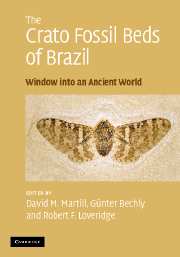Book contents
- Frontmatter
- Contents
- Contributors
- Preface
- Acknowledgements
- Part I The Crato Formation Konservat Lagerstätte
- 1 Introduction to the Crato Formation
- 2 The geology of the Crato Formation
- 3 Stratigraphy of the Crato Formation
- 4 The sedimentology and depositional environment of the Crato Formation
- 5 Commercial exploitation of the Crato Formation
- 6 Preparation techniques for Crato Formation fossils
- Part II The invertebrate fauna
- Part III The vertebrate fauna
- Part IV The flora
- Part V Miscellanea
- Appendix: species list for the Crato Formation
- Systematic index
- Plate section
- References
4 - The sedimentology and depositional environment of the Crato Formation
Published online by Cambridge University Press: 22 August 2009
- Frontmatter
- Contents
- Contributors
- Preface
- Acknowledgements
- Part I The Crato Formation Konservat Lagerstätte
- 1 Introduction to the Crato Formation
- 2 The geology of the Crato Formation
- 3 Stratigraphy of the Crato Formation
- 4 The sedimentology and depositional environment of the Crato Formation
- 5 Commercial exploitation of the Crato Formation
- 6 Preparation techniques for Crato Formation fossils
- Part II The invertebrate fauna
- Part III The vertebrate fauna
- Part IV The flora
- Part V Miscellanea
- Appendix: species list for the Crato Formation
- Systematic index
- Plate section
- References
Summary
Although the exceptionally preserved fossils from the Crato Formation have attracted a multitude of palaeontological studies dealing predominantly with the systematics and taxonomy of the assemblage, reports on the sedimentology and depositional environment of this important Fossil Lagerstätte are rather scarce. There are even fewer studies on the geochemistry and sedimentary diagenesis of the formation. A few exceptions include analyses of the organic matter composition (Baudin and Berthou, 1996; Neumann, 1999; Neumann et al., 2003) and a study of evaporite mineral pseudomorphism in the Nova Olinda Member (Martill et al., 2007). Some workers have examined spot samples from the Crato Formation in studies on the Araripe Group as a whole (e.g. Berthou et al., 1990) and a few assessments of the palaeoenvironment have been undertaken (Cavalcanti and Viana, 1990; Martill and Wilby, 1993). For a better understanding of the unusual taphonomy and exceptional preservation of the Crato fossils, a more detailed knowledge of the physico-chemical conditions of the aquatic palaeoenvironment is necessary. Because the Crato Formation is a heterolithic sequence with both clastic and carbonate deposition, it is clear that many different and often contrasting environments are represented by the sedimentary sequence. Many previous analyses fail to address the situation, preferring to summarize the unit as a whole, and providing generally unsatisfactory interpretations. Here we concentrate on the sedimentology and geochemistry of the Nova Olinda Member of the Crato Formation, with a view to elucidating the sedimentary and diagenetic environment that resulted in the exquisite preservation of the fossil assemblage.
- Type
- Chapter
- Information
- The Crato Fossil Beds of BrazilWindow into an Ancient World, pp. 44 - 62Publisher: Cambridge University PressPrint publication year: 2007
References
- 12
- Cited by



